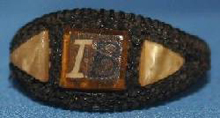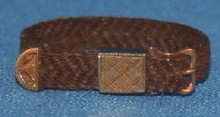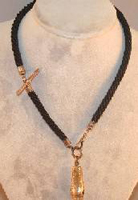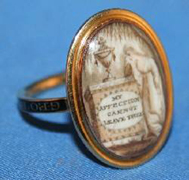| |||
|
Hairwork: A Sentimental Folk Art Written by Guest Columnist: Pat Martin We tend to think of hairwork pieces as mourning pieces, but hairwork was more the sharing of affection rather than grief. Napoleon wore a lock of his wife’s hair woven into a watch chain. Queen Victoria gave jewelry made from her hair as presents to her children. Evidence of hair jewelry
We are fortunate to be able to study early styles of art and acceptable practices of affection and emotion through the study of hairwork. Search for hairwork on Dig Antiques to see some wonderful examples. About Pat Martin Here are a few interesting references on hariwork:
|
|
Visit the Shops at Dig Antiques The Shops on Dig Antiques continue to grow. Some Shop owners actively change items in their Shop at least once per week. Just click to visit the Shops and enjoy! We are continuously making improvements to Dig Antiques. Some are obvious and some are behind the scenes. For instance, the Shop Panel has recently been improved with a new method of uploading pictures that makes it even earier to use. As one Shop owner said: "This couldn't get any easier! You've taken the fear out of having an online shop." Are you looking for a way to sell your country and folk art antiques, Americana, and decorative arts online? Open Your Own Shop on Dig Antiques starting at just $149/year. Dig Antiques tote bags are available to order here and we'll ship it right out to you! |
|
We hope you enjoy this issue of the Dig Antiques Newsletter. Thanks so much to Pat Martin for her interesting article on hairwork. Do you have expertise and interest in writing a column? If so, please let us know. |
|
Search Showcase Have you been digging for antiques recently? |
|
August 2010 Top Searches Below is a summary of the twenty most popular search phrases last month.
1. stoneware crocks |
|
Sponsors |
|
Thank you to the following current advertisers for their support of Dig Antiques:
Ames Gallery If you are interested in supporting Dig Antiques through advertising, please click here. |
|
Contact Us |
|
For general information:
Website: www.digantiques.com |
|
© 2010 Dig Antiques. All rights reserved. |

 has been traced as far back as the 17th century,when bracelets were woven as love tokens by both women and men. Hair was used because it was everlasting and did not decay. In the days when there were no photographs or videos through which to feel close to loved ones, and when so many were too poor to employ portraitists, hair tokens were cherished.
has been traced as far back as the 17th century,when bracelets were woven as love tokens by both women and men. Hair was used because it was everlasting and did not decay. In the days when there were no photographs or videos through which to feel close to loved ones, and when so many were too poor to employ portraitists, hair tokens were cherished. It was common practice for hairwork beginners to practice with horse hair, which is coarser, has more body and is easier to handle than human hair. Advanced workers have made beautiful and intricate weaves, plates, garlands and plumes with human hair, and have also made figural pictures. If you look closely at each of these rings, it is apparent that the horse hair in the top ring is thicker and rougher than the smooth, fine human hair in the bottom buckle ring.
It was common practice for hairwork beginners to practice with horse hair, which is coarser, has more body and is easier to handle than human hair. Advanced workers have made beautiful and intricate weaves, plates, garlands and plumes with human hair, and have also made figural pictures. If you look closely at each of these rings, it is apparent that the horse hair in the top ring is thicker and rougher than the smooth, fine human hair in the bottom buckle ring.  There are 3 basic techniques in working with hair. One is table work in which hair weaving is done on a table with a central hole. Hair is weighted by bobbins similar to lace bobbins and worked up through the hole, into intricate patterns. Hollow work, a type of table work, used molds around which hair was formed and then hardened to retain its tubular form. Table work is mostly found in the creation of bracelets, necklaces, earrings, rings and watch chains. Palette work is that in which hair was glued flat onto a base. It is used most often in brooches or in artwork.
There are 3 basic techniques in working with hair. One is table work in which hair weaving is done on a table with a central hole. Hair is weighted by bobbins similar to lace bobbins and worked up through the hole, into intricate patterns. Hollow work, a type of table work, used molds around which hair was formed and then hardened to retain its tubular form. Table work is mostly found in the creation of bracelets, necklaces, earrings, rings and watch chains. Palette work is that in which hair was glued flat onto a base. It is used most often in brooches or in artwork. Sepia painting in jewelry and in miniatures on ivory used both silk and hair embellishments. Also, macerated hair was mixed with the sepia or inks to be used in the actual brushstrokes on the ivory. Sepia paintings could be either lovers’ tokens or mourning pieces. The artwork on ivory was protected by mica in the earlier pieces, then by crystal and lastly by glass.
Sepia painting in jewelry and in miniatures on ivory used both silk and hair embellishments. Also, macerated hair was mixed with the sepia or inks to be used in the actual brushstrokes on the ivory. Sepia paintings could be either lovers’ tokens or mourning pieces. The artwork on ivory was protected by mica in the earlier pieces, then by crystal and lastly by glass.